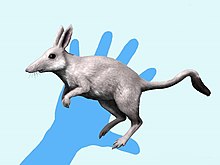Polydolopimorphia
| Polydolopimorphia Temporal range:
| |
|---|---|

| |
| Argyrolagus palmeri | |
| Scientific classification | |
| Kingdom: | Animalia |
| Phylum: | Chordata |
| Class: | Mammalia |
| Clade: | Metatheria |
| Clade: | Marsupialiformes |
| Order: | †Polydolopimorphia Archer, 1984 |
| Subgroups | |
| |
Polydolopimorphia is an extinct order of metatherians, more closely related to extant marsupials than other extinct mammals. Known from the Paleocene-Pliocene of South America and the Eocene of Antarctica, they were a diverse group during the Paleogene, filling many niches, before declining and becoming extinct at the end of the Neogene.[1] It is divided into two suborders, Bonapartheriiformes, and Polydolopiformes [2]
Taxonomy[]
Taxonomical subdivision of the Polydolopimorphia:[3]
- Suborder Bonapartheriiformes
- Family Pascual 1980
- Genus Pascual 1980
- Genus Paula Couto 1952
- Family Ameghino 1904
- Genus Carlini et al. 2007
- Genus Argyrolagus Ameghino 1904
- Genus Hondalagus Villarroel & Marshall 1988
- Genus Flynn & Wyss 1999
- Genus Ameghino 1904
- Genus Wolff 1984
- Subfamily Sigé et al. 2009
- Genus Chulpasia Crochet & Sigé 1993
- Genus Archer et al. 1993
- Family Pascual 1980
- Genus Goin & Candela 2004
- Genus Goin et al. 1999
- Genus Goin et al. 1998
- Family Goin et al. 2010
- Genus Hondonadia Goin & Candela 1998
- Genus Goin & Candela 1996
- Family Pascual 1980
- Suborder Polydolopiformes
- Family Polydolopidae Ameghino 1897[4]
- Genus Ameghino 1902
- Genus Antarctodolops Woodburne & Zinsmeister 1984
- Genus Ameghino 1903
- Genus Chornogubsky 2020
- Genus Goin et al. 2010
- Genus Ameghino 1902
- Genus Ameghino 1897
- Genus Ameghino 1902
- Family Crochet & Sigé 1996
- Genus Crochet & Sigé 1996
- Genus Marshall et al. 1983
- Family Polydolopidae Ameghino 1897[4]
- incertae sedis
- Genus Pascual 1980
- Genus Goin & Candela 2004
- Genus Paula Couto 1970
References[]
- ^ Beck, Robin M. D. (2016). "The Skull of Epidolops ameghinoi from the Early Eocene Itaboraí Fauna, Southeastern Brazil, and the Affinities of the Extinct Marsupialiform Order Polydolopimorphia". Journal of Mammalian Evolution. 24 (4): 373–414. doi:10.1007/s10914-016-9357-6. ISSN 1064-7554. PMC 5684316. PMID 29187780.
- ^ Chornogubsky, Laura; Goin, Francisco J. (2015). "A review of the molar morphology and phylogenetic affinities of Sillustania quechuense(Metatheria, Polydolopimorphia, Sillustaniidae), from the early Paleogene of Laguna Umayo, southeastern Peru". Journal of Vertebrate Paleontology. 35 (6): e983238. doi:10.1080/02724634.2015.983238. ISSN 0272-4634.
- ^ Polydolopimorphia at Fossilworks.org
- ^ Laura Chornogubsky (2021). "Interrelationships of Polydolopidae (Mammalia: Marsupialia) from South America and Antarctica". Zoological Journal of the Linnean Society. 192 (4): 1195–1236. doi:10.1093/zoolinnean/zlaa143. Along with:
- Enrico de Lazaro: [http://www.sci-news.com/paleontology/polydolopid-marsupials-09287.html Three New Species of Extinct Marsupials Identified, sci-news, Jan 26, 2021
Categories:
- Metatheria



